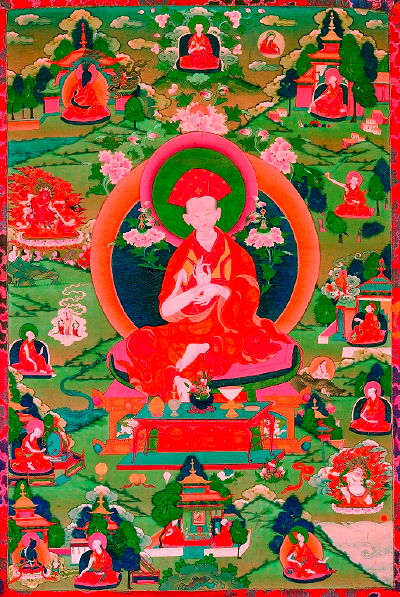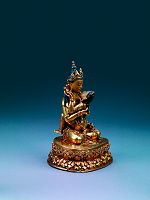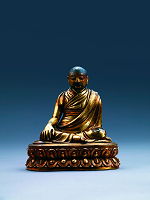
Künkhyen Pema Karpo, XVIIIth century, ink and mineral colors on cotton
H. 154 cm ; L. 104,5 cm, Gönpa from Trashigang, Thimphu, photo credits © Shuzo Uemoto |
|
MUSÉE GUIMET
6, place d’Iéna – 75116 PARIS
INFORMATION:
Tel. 01 56 52 53 00
Website : www.guimet.fr
ADMISSION PRICE:
Full rate: 8 €.
Reduced rate: 6 €.
Ticket museum/exhibition: 9.50 € (full rate); 7 € (reduced rate).
Permanent collections:
Admission to museum: 6. 50 € (full rate); 4.50 € (reduced rate); free for visitors under 26
CURATORSHIP:
Nathalie Bazin, heritage curator, Nepal-Tibet section of the musée des arts asiatiques Guimet.
PRESS CONTACTS:
Hélène Lefèvre, Head of the Communication service
Tel. 01 56 52 53 32 Fax 01 56 52 53 54
E-mail : helene.lefevre@guimet.fr
Sophie Maire, assistant
Tel. 01 56 52 54 11 Fax 01 56 52 53 54
E-mail : sophie.maire@guimet.fr

|
This exhibition was conceived by the Arts Academy of Honolulu, together with the Culture Department of the Royal Bhutanese Government and the Central Monastery Authority, and is a big premiere in the Western world. It invites the public to discover works which to this date had never been presented outside of the Bhutanese borders. The exhibition is also an opportunity for the musée Guimet to get associated to the celebration of the centennial of the Wangchuk dynasty’s reign and the adoption by Bhutan in 2008 of its first constitution.
The major themes of tantric Buddhism
By bringing together for the first time an ensemble of over one hundred Buddhist pieces that have remained objects of worship, on loan by more than thirty temples and monasteries in the Bhutan kingdom– located in the Himalayas between Tibet and the Indian state of Assam - the Guimet museum offers the public a unique possibility of discovering the major iconographic themes of tantric Buddhism. Bhutan’s official religion is approached by referring to the country’s artistic traditions, their historic developments as well as the principal religious figures that peopled its history. This esoteric form of Buddhism was born in India and was transmitted to the Himalayan region, to Tibet and Bhutan, during the VIIIth century. Padmasambhava, the famous master from Swât, today the region North of Pakistan, was then one of the main vectors of this diffusion.
Thangkas painted and embroidered
The pieces presented go from the VIIIth to the XIXth centuries, and illustrate in particular the golden age of Bhutanese art between the XVIIth and XIXth centuries, rich with a complex and subtle iconography. The exhibition presents a rare ensemble of painted or embroidered thangkas, some of them with very large dimensions, as well as metallic sculptures and liturgical objects. Dance, which occupies an important place in tantric Buddhism iconography, is evoked in the excerpts from movies filmed in Bhutan and shown during the exhibition. These ritual Buddhist dances, or cham, performed during celebrations, have been preserved in the country at an unequaled pure state, and some of them are linked to figures largely referred to through the works in the exhibition, such as Padmasambhava.
Illustration: Vajrasattva and his goddess, XVIIIth century, golden copper alloy, cold gilding, pigments and turquoise inlays. H. 17.5 cm; L. 13.8 cm; D. 10 cm.
Norbugang Zimgong Lhakhang, Punakha. Photo credits: © Shuzo Uemoto
An enduring fascination
The exhibition is accompanied by photographs that prove the fascination exercised by Bhutan and this unique spirituality. Near the exhibition galleries, on the ground floor giving to the garden, we can admire coloured photographs taken in Bhutan by the monk Matthieu Ricard, the author of a recent work on the Himalayan kingdom where he has often resided. The Lacquer Rotonda (Rotonde aux Laques), on the last floor of the museum, offers another choice of original photographs, in black and white, taken and developed directly by Jean Timsit, with a folding camera with a bellows.
Illustration: Je Shakya Rinchen, XVIIIth century, golden copper alloy, cold gilded and pigments. H. 17.6 cm; L. 16.5 cm; D. 13 cm. Gönpa from Phajoding, Thimphu. Photo credit: © Shuzo Uemoto
PUBLICATION:
Au pays du Dragon: arts sacrés du Bhoutan, (In the country of the Dragon: sacred arts of Bhutan) catalogue of the exhibition-Editions RMN/ Musée Guimet, 392 p., 50 €. With a DVD of ritual dances. The authors wished to underline the stylistic and iconographic elements that contribute to distinguish the Bhutan works from the Tibetan ones, thus marking an important phase in the development of the studies on the subject.
To see more illustrations, click on VERSION FRANCAISE at the top of this page
|




